High-pressure, injection-molded MacroBins® have been designed specifically to overcome the many short-comings of wood and other previously available bins, such as those made from low-pressure structural foam. MacroBins were originally molded from High Density Polyethylene (HDPE). Most MacroBins purchased after 2001 are molded from Polypropylene (PP) as advances in PP technology have made it a more durable material for bins used in agriculture. To achieve maximum benefit from the use of MacroBins, it is important to understand the differences between plastic and wood bins and to modify handling practices accordingly.

Table of Contents
Safe Use Of MacroBins
Safe Handling Practices
Bin Transportation
Corner Irons and Cables
Flatbed Single or Double Trailers
Bin Movement – Forward / Backward
Florida Bin Loading on Trailers
Straddle Lift Trailers
Pick-up Trucks and Small Trucks With Flatbeds
29 Series Transportation
32/34, 32NG, and 33 Series Transportation
Denesting / Nesting Procedure
Storage
Maximum Capacity and Stack Weight Limits
Fire Commodity Classification Ratings
Interstacking
Temperature Ranges
Handling Equipment
Forklift Handling
Malavac Dumper
Straddle Fork
Bin Trailers
Motorized Bin Carriers
Lightning Loaders
Packinghouse Equipment
Destackers
Dumpers
Stackers
Floaters
Pre-Sizing Lines
Bin Identification
Maintenance
Repair of Damaged Panels
Cleaning
Foot Replacement
Recycling
Index of Safety Information Sources
Safe Use Of MacroBins
MacroBins have been designed for the harvesting, transportation, and storage of fruit, vegetables, and other types of commodities. All MacroBins are molded from materials that have been tested and are in compliance with FDA guidelines for food contact. MacroBins can also be used to transport or store non- agricultural contents as long as design specifications are adhered to.
MacroBins must be used in accordance with design specifications that are outlined on the product specification sheets published for each bin model. Product specification sheets are available from Macro Plastics Sales Representatives, the Technical Services Department, or online at www.macroplastics.com and should be fully reviewed before MacroBins are used. The following must be observed:
- Older solid MacroBins molded from HDPE are not suitable for liquid storage. Solid bins molded from PP can be used for liquid storage.
- When storing materials other than agricultural commodities, when treating commodities stored in MacroBins or when clean or sanitizing MacroBins, the resistance of HDPE or PP to degradation due to contact with these chemicals should be reviewed. This should be done by contacting your sales Representative or the Customer Service Department. If there is any doubt as to the suitability of chemicals used on MacroBins, testing should be completed to ensure the MacroBins will not be damaged from long-term contact with the chemical in question.
- Heavy objects should not be dropped onto the floor of the bin as they could damage the bin floor.
- Holes should not be drilled in the bins as any modification to MacroBins will void the warranty and may negatively impact the structural integrity of the bins.
- MacroBins with damage to the corner post should be taken out of service and recycled.
- MacroBin stacks must not be pushed over or off of trucks onto hard surfaces such as concrete.
- MacroBins should be periodically inspected for structural damage to the corner posts and upper ribs. This is very important in applications where MacroBins are stacked, as the corner posts bear most of the load. Any cuts or cracks that damage the interior support ribs of the corner posts may cause structural failure in a stack. MacroBins found in this condition should be recycled.
Safe Handling Practices
Bins must be secured to the vehicle used for transport in a manner that eliminates bin movement while the vehicle is moving, even if only a single bin is involved. All bins should be forced together without space between them to form a unitized load. The U.S. Department of Transportation (DOT) does not currently have a commodity specific cargo securement technique for the transport of bins. To understand the most effective cargo securement techniques for the interstate transport of MacroBins, the DOT – Federal Motor Carrier Safety Administration (FMCSA) has the Federal Motor Carrier Safety Regulations (FMCSRs) available on the FMCSA website at www.fmcsa.dot.gov. The general cargo securement requirements are listed under 49 CFR 393.100 – 393.114.
For intrastate travel, tie-down methods must comply with local regulations regarding bin hauling. It is the responsibility of the user to ensure they are in compliance with these regulations. Internet links to truck-related regulation web sites for all 50 states are listed in the index at the end of this User Guide. This information will be updated periodically at www.macroplastics.com. The U.S. Department of Transportation – Federal Motor Carrier Safety Administration (FMCSA) has the Federal Motor Carrier Safety Requirements available on the FMCSA website at www.fmcsa.dot.gov. The general cargo securement requirements are listed under 49 CFR 393.100 – 393.114. Some of the more widespread bin transportation methods are outlined in this section.
In many areas of the country, corner irons and cables are utilized in the transportation of empty bins or bins filled with agricultural produce. Due to the rounded corners of MacroBins, corner irons used to secure wood bins will tend to roll around the corner as the cable is tightened. To eliminate this problem, it is highly recommended that corner irons be used that satisfy the following guidelines:
- The corner iron sides must be at least 5” wide.
- Length should be at least 22” for MacroBin Models 12 and 14.
- Length should be at least 28” for Model 16.
- Length should be at least 34” for Models 24, 26, 28, 32, 33 and 330.
- Length should be at least 40” for Models 34 and 44 (T-Bin).
- Length should be at least 60” for Model 48.
- The cable hook should be 12” to 24” from the top of the bin in use.
- The top hook should be designed to hook over the corner post.
Corner irons can be purchased from your local Utility Trailer Distributor. Go to www.utilitytrailer.com for the location of your local distributor.
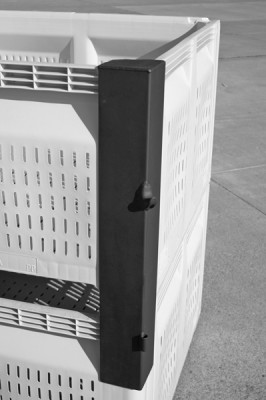
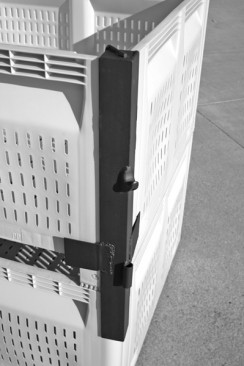
If corner irons used to secure wood bins continue to be used, Macro Plastics recommends they be modified in the following manner:
- A 4” wide tab that extends to the point where the corner post wall meets the side panel wall must be installed extending toward the center of the side and front of the bin.
- The corner iron length guidelines referenced on page 3 should be followed.
- The top hook should also be modified to securely hook over the corner post.
Flatbed Single or Double Trailers
MacroBins offer distinct advantages over wood bins when hauling on trailers due to the interlocking feature of the foot with the top of the MacroBin beneath it. This allows for proper positioning while stacking MacroBins. The upper bin will not fall into the bin below and a more stable block is formed when corner irons and cables are used to contain the bins.
MacroBins are lighter than wood bin and the plastic surface is smoother, so they may slide more than wood bins in transport if not properly secured. To minimize sliding issues when transporting MacroBins, precautions should be taken to prevent bins from sliding forward or backward, as well as side-to-side.
Bin Movement – Forward / Backward
The force of the wind hitting the front stack of bins tends to force the load on a trailer to the rear. Also, depending on the locations of the winches and hooks, cables can force the block forward, back, or just inward and down. A sudden stop may cause the bins to slide forward. 49 CFR 393.102 of the FMCSA general cargo securement rules requires that any securement system prevent movement of the load in a 0.435g deceleration in the forward direction or a 0.5g deceleration in the rearward direction. To ensure that this is done, Macro Plastics recommends that all rows be secured with cargo securement devices meeting the requirements of 49 CFR 393.104 and 393.108 of the FMCSA general cargo securement requirements. In addition to using the proper cargo securement devices, the following points should be considered:
- Use trailers with front bulkheads.
- Weld angle iron stops to the front and rear of the trailer.
- If stake holes are present at the front and rear of the trailer, stakes can be placed in these holes.
Above options must all comply with the requirements of 49 CFR 393.104.
Bin Movement – Side to Side
As double trailers are pulled down the highway, the rear trailer can sway from side to side creating the potential for side drift of bins. Hard corners and high winds further contribute to this problem, increasing the probability of side drift. The FMCSA cargo securement regulation 49 CFR 393.102 states that loads must be secured to prevent movement in 0.25g lateral acceleration. To ensure that this is done, Macro Plastics recommends that all rows be secured with cargo securement devices meeting the requirements of 49 CFR 393.104 and 393.108 of the FMCSA general cargo securement requirements. If winches are not present, suitable rope can be used.
See 49 CFR 393.108 in the FMCSA general cargo securement regulations.
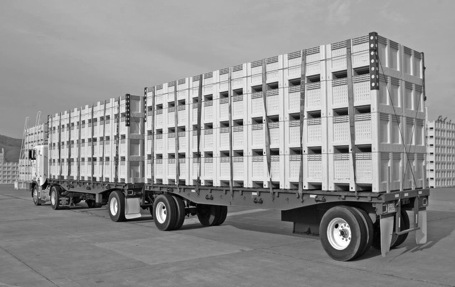
Bin Loading on Trailers
When loading MacroBins onto trailers the following guidelines are recommended:
- On trailers without a headboard or other stops at the front and rear of the trailers, it is recommended that stakes be put in place before loading, if stake pockets are available. Stakes should be placed at both ends of each of the trailers and comply with 49 CFR 393.104.
- Load the bins starting at the bulkhead end of the trailer with the bins placed tight against the bulkhead, stakes, or stops. The bin stacks should be loaded tightly together to form a unitized block. It is important to pack the bins tightly together before corner irons and cables are put into place. This will require less force to be applied to the corner irons and cables to pull the bins together, as all bins must be touching when the tie-down is complete.
- After all bins are loaded, corner irons should be put into place so cables can be fitted. To help with fitting corner irons, provisions should be made to safely lift corner irons onto empty bin loads stacked four high. Corner irons, cables, clamps, as well as attachment and anchor points on trailers must be inspected before each use to ensure they are in good condition. See 49 CFR 393.104 of FMCSA Cargo Securement Rules.
- Cables should then be put in place and tightened.
- Cables are needed to securely hold down the load and force bins together tightly. Over-tightening the cables can cause deformation of the corner posts, so care must be taken when tightening cables.
- To ensure that the load is secure as possible, Macro Plastics recommends that each row of MacroBins be secured using straps which meet the requirements as specified in DOT Federal Motor Carrier Safety Regulation (FMCSR) 393.104, in addition to the corner irons and cables. The cargo securement system used must meet the general cargo securement requirements as listed under 49 CFR 393.100 – 393.114.
- The load should be checked after fifty miles of travel to ensure that it is still secure. If needed, the cables and cross ties should be tightened again to ensure that bins are still packed tightly together, as bins may shift during transit causing slack in the cables. Tightening the cables at this time is a very important step and must not be neglected. Additional checks should be made for longer trips as per 49 CFR 392.9.
- Posted speed limits for trucks should be strictly adhered to.
Florida Bin Loading on Trailers
The recommended tie-down method for Florida citrus use is illustrated in the Florida tie- down photograph (above). To tie down a trailer in this manner, six corner irons are required unless the bulkhead of the trailer is equipped with cable guides on the bulkhead as illustrated in the bulkhead photograph (below). If the bulkhead is prepared in this way, four corner irons are needed, two per side. The front and rear of the top stack must be secured with corner irons and the cables must be crossed at the rear and attached to the trailer as illustrated. Before hanging corner irons and cables, it is important to pack the bins tightly against each other to form a unitized load, as all bins must be touching when the tie-down is complete.
In addition, Macro Plastics also recommends that each row of MacroBins be strapped down using straps which meet the requirements as specified in DOT Federal Motor Carrier Safety Regulation (FMCSR) 393.104. All cables, cable clamps, and corner irons should be thoroughly inspected before use and fixed or replaced immediately if any problems with the equipment are found. FMCSR 393.104(b) specifically prohibits the use of damaged cargo securement devices, including damaged or weakened components that will affect their performance, and specifically prohibits the use of components with cracks or cuts. Loads should be checked after fifty miles of travel to ensure the cables and tie-down straps are tight. If the load has loosened, the straps must be securely tightened. The load should be checked further as detailed in 49 CFR 392.9. Posted speed limits should be strictly adhered to.
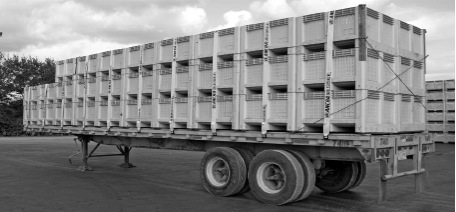
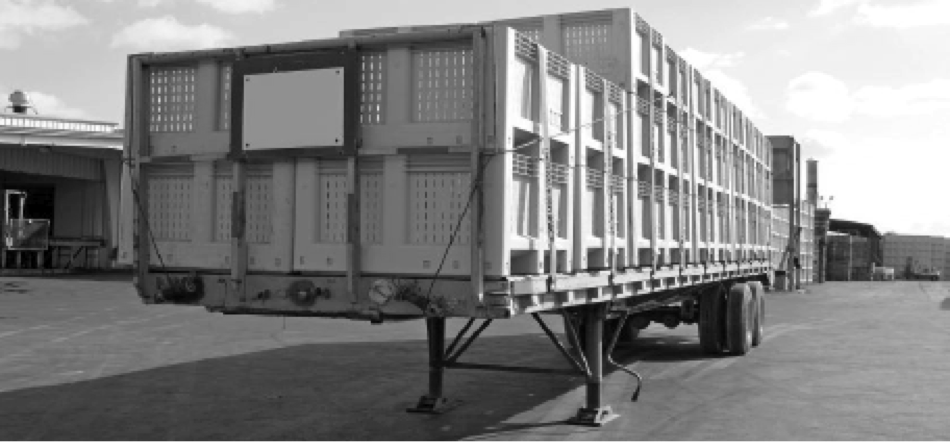
Straddle Lift Trailers
No special handling is required when using straddle trailers. Existing straddle platforms consist of steel tubing or wood timbers connected with four or five cross-members. These must be prepared for MacroBin use with the addition of a steel or plywood plate connecting the tubes. This plate must be attached to the top and run the full length of the platform, ensuring the center post area of the bin is supported, regardless of where the bin is placed on the platform. This will prevent damage to the stringer under the open area of the foot.
Pick-up Trucks and Small Trucks With Flatbeds
When transporting empty or full MacroBins in a pick-up truck or small flatbed, the bin or bins must always be secured and covered to prevent loss of the bin or its contents. On flatbeds, bins must be strapped down as on larger flatbed trailers. After securing a bin, it should be checked to ensure it cannot move. In addition to securing the bin, it is also imperative that the tailgate be closed. If the truck does not contain hooks or cleats to secure a bin, or there is no tailgate in place, bins must not be transported in this truck. It is also essential that nothing is placed in the space between the bin and the tailgate. When transporting bins of differing heights, the taller bin should be secured against the cab, out of the wind stream, and the shorter bin should be placed toward the rear of the truck bed. The secured bin should be checked periodically to ensure that it continues to be secure for transport.
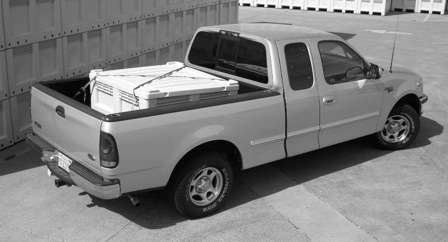
29 Series Transportation
To protect the Macro 29 bins, Macro Plastics recommends using Vee Boards to strap the bin down. These boards are 9″x9″x36″ and will protect the walls and the lip of the bin. The extension pole is 8 feet and is used place the Vee Boards on top of the bins securely. The pole and vet board can be purchased at uscargocontrol.com.
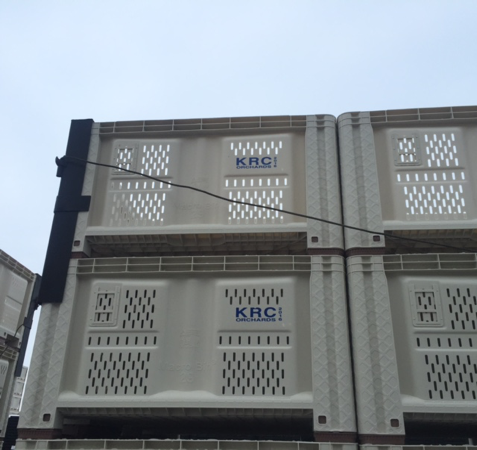
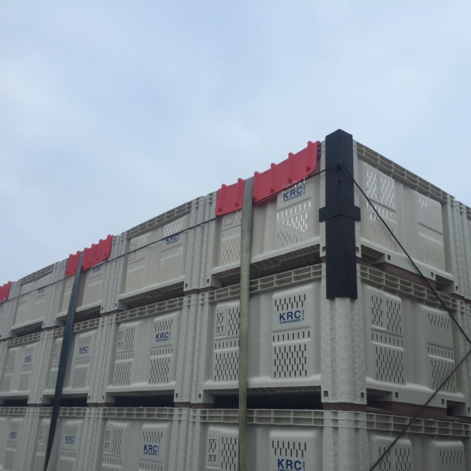
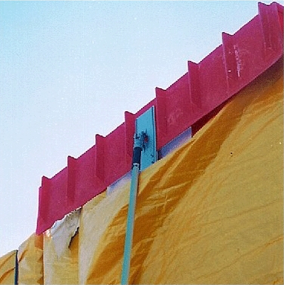

32/34, 32NG, and 33 Series Transportation
The 32, 34, 32NG and 33 Series MacroBins can be transported on trailers stacked normally or can be nested using the nesting procedure outlined below. Nesting enables three bins to be transported in the space of two. Macro Plastics recommends that nested stacks be transported on trailers as illustrated in the tie-down photo below with a single nest stacked on top of a single bin. This load should be tied down using straps that meet the requirements as specified in DOT Federal Motor Carrier Safety Regulation (FMCSR) 393.104, in addition to the corner irons and cables. The cargo securement system used must meet the general cargo securement requirements as listed under 49 CFR 393.100 – 393.114.
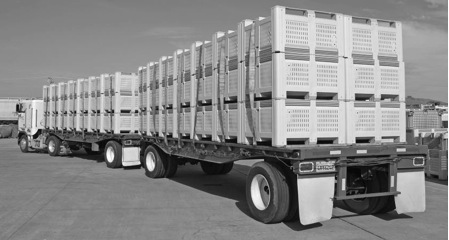
The following procedure should be followed when denesting bins:
- Using a forklift, lift the upper bin by the feet, removing it from the nest. (Photo #1)
- Remove the interior bin using the forks to lift the bin as shown. (Photo #2)
Denesting can also be done using the following procedure:
- Nested bins should be tilted and lowered to the ground onto their sides as slowly as possible and then denested by hand.
- Pull the bins apart and place them right side up for use.
- The nest should never be pushed over and slammed onto concrete or asphalt as this may result in cracking of the interior corner posts.
Nesting is the reverse of the denesting procedure.
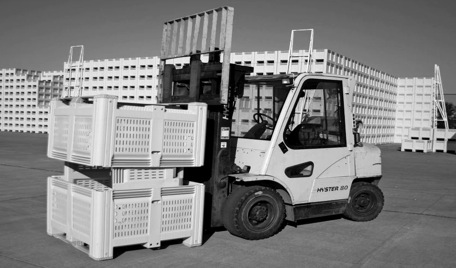
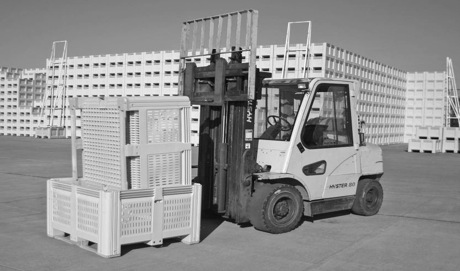
Storage
With their interlocking foot design, consistent dimensions, and dimensional stability over time, MacroBins offer significant improvements over wood bins in space utilization and room filling efficiency. MacroBins stack straight, reducing the space required between bins, and in many cases increasing storage volume significantly. Empty MacroBins can be stored outside, as they are molded using a state-of-the-art UV stabilization system. Recommendations for the safe storage of full or empty bins are as follows:
MacroBins should always be stacked on hard level surfaces. When stacking more than four high, bins should only be stored in blocks of at least two stacks side by side. In general, the higher the stack, the wider the block. This will reduce the risk of bins being blown over by high winds.
When MacroBins are stored more than four high, they should be located in an area away from personnel activity. Unauthorized individuals should be kept away from bin stacks.
Care should be exercised when de-stacking non-vented MacroBins outdoors as the stack could be top heavy as a result of rainwater accumulation in the top bin.
Because the 26 and 27 Series MacroBins are square and the stacking design is the same at each corner, it is possible to turn them 90 degrees when stacking on the bin below, but this must not be done. The corner posts are designed to transfer more of the weight to the side of the bin where the feet run the length of the bin and provide the necessary support.
32/34, 32NG, and 33 series bins should not be stored in the nested configuration described in the Transportation section above. Stability and uniformity of the stack is dependent upon feet of the bin above being nested in the collar of the bin below. Storing and transporting bins in the nested configuration is inherently less stable and should only be done during shipping where additional load securement is used.
Maximum Capacity and Stack Weight Limits
MacroBins have been designed to perform within specific maximum load capacities and stacking tolerances. For capacity and stack weight limits for MacroBins, please refer to Macro Plasticsʼ product specification sheets.
Fire Commodity Classification Ratings
For insurance purposes, call the Macro Plastics Technical Services Department for questions regarding Fire Commodity Classification Ratings. All MacroBins have a Commodity Classification Rating of Class III or better.
Interstacking
It is essential to ensure that load stresses are transferred in the designed manner in a stack of bins. To achieve this, MacroBins have been designed with a patented interlocking foot which ensures the proper bearing of loads. Under no circumstances should MacroBins be interstacked with wood bins or other manufacturer’s plastic bins. Furthermore, the dimensions and interlocking systems differ between individual MacroBin models. MacroBin models can be interstacked with each other in the following groupings:
- 12 with 12 Series only
- 14 with 14 Series only
- 16 with 16 and 24 Series only
- 24 with 16 and 24 Series only
- 26 with 26 Series only
- 28 with 28 Series only
- 32 with 32 and 34 Series only
- 33 with 33 Series only
- 34 with 32 and 34 Series only
- 44 with 44 Series only (formally T-Bin)
- 48 with 48 Series only
- 330 with 330 Series only
- 32NG with 32NG, 32 and 34 Series only
Note: When interstacking bins of different heights forklift opening heights will vary Therefore care must be taken when handling bins with double-wide forklifts.
Temperature Ranges
MacroBins can be used over a wide range of temperature environments and filled with contents that fall within these ranges. MacroBins can be used within the following temperature ranges:
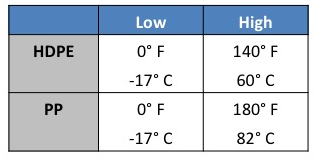
Handling Equipment
MacroBins are smoother and lighter than wood bins. This must be taken into account when handling empty MacroBins. The following rules should be followed when transporting empty bins on forklifts:
- Travel in reverse, as bins obstruct visibility in forward direction.
- Travel with forks tilted back, as plastic bins will slide more easily on forks than wood bins.
- Make sure the forks are raised high enough to prevent the rear corners of the feet from dragging along the ground.
- Slow when cornering or driving over rough surfaces as empty bins may tip or bounce off of the forks.
- If the bins start to tip, quickly lower the forks so the feet contact the ground, stabilizing the stack.
- Never transport more than four bins high on a forklift.
- Maintain fork tips to ensure there are no large burrs or sharp edges as this will reduce damage to the radiused forklift entry area.
- When forklift rotators are used for dumping bins, rotator systems utilizing a clamp are recommended to prevent any movement of the bin when dumping.
- Bins should be properly aligned, with feet nested in the collar of the bin below. 32/34, 32NG, and 33 series bins should only be handled in the nested configuration in order to de-nest them as described in Denesting/Nesting Procedure.
Malavac forklift dumpers can be used without damage to MacroBins if they are correctly adjusted, the adjustments are maintained or locked in, and the dumper is used properly.
To initially set the adjustment:
Set the flapper forward / back adjustment so the distance between the rear frame and the closed flapper is 1/8” less than the bin length. This will firmly hold the bin in place without crushing the corner post, as well as prevent the bin from moving when dumping.
To lock this adjustment:
Tack weld a 3/8 square steel plate to the flapper adjusting arm, touching the frame, to act as a stop when the flapper is run into a solid object. The plate will prevent the adjusting arm from being forced in.
Malavac dumpers should never be used to push loaded bins with the flaps closed. This will bend the flappers and adjusting arms and force them out of adjustment.
The clamp fork tractor (Wiggins Clamp) widely used in the citrus industry to handle bins in the orchard can be adapted to handle MacroBins. The modifications needed involve the addition of a bumper at the foot of the forklift mast extending out 6” on either side. This bumper impacts the corner post instead of allowing the lower corner of the mast to strike the vented area of the sidewall when the mast is tilted back. To prevent damage to the top rim, the installation of a bin edge protector on the upper clamp frame is recommended.
When removing full bins from orchard rows, they are rarely squared with the front of the forklift. To square bins for stacking, the bin on the ground must be square to the bin on the forks. The operator can either push the bin on the ground forward with the bin on the forks until it is square, or raise the forks above the bin on the ground and push the bin forward with the mast. To prevent bin damage, the second option is preferable provided that the forklift mast is fitted with a bumper as outlined above.
Most bin trailers require no modifications to handle MacroBins. Modification is required
when the top of the rollers are below the level of the top of the frame. This may cause the bin foot to rest on the frame instead of the rollers, thus preventing the bin from easily rolling off the trailer. In such cases, the rollers must be raised to a point where the top of the roller clears the top of the frame. This will allow the bin to roll freely. Depending on the height, the rollers must be raised. This can be done by either:
- Removing the rollers and adding a sleeve to increase the roller diameter.
- Re-drilling and raising each roller to clear the frame.
Most motorized bin carriers can handle MacroBins with no modifications. The issue that may arise is the ability of the bin to travel in the recessed chain tracks. On some models, the path down the inside of this track is blocked by bolts or features along the frame preventing the bin from freely traveling on the chains as the inside edge of the foot impacts on the inside frame. On some models, bolts must be shortened to allow the bin to freely travel on the chains. To allow for a MacroBin to travel freely, the following requirements must be met:
• The inside of the frame can be no more than 35” wide for the 24 Series MacroBins and no more than 37.5” for the 26 Series MacroBins.
The Lightning Loader Citrus Harvesting System manufactured by Petersen Industries, Inc. in Florida has lifting heads specifically designed for handling MacroBins.
When using Lightning Loaders with MacroBins, Macro Plastics recommends the following guidelines be followed:
- Loader heads that have been converted from the spring loaded actuation to hydraulic cylinder actuation of the Peterson head gripping bars should never be used with MacroBins. Use of these heads will result in damage to the rib area at the top of the MacroBin, reducing bin life.
- Lightning Loader heads are designed to rotate 360 degrees using a hydraulic spinner. The manufacturer recommends that the head be spun at no more than six RPMs when utilizing the spinner. On some loaders, the spinner can be operated at a higher spin rate causing damage to MacroBins as well as the loader head. A restrictor is available that will limit the speed of the spinner to six RPMs. This restrictor is highly recommended as a safety feature and will prevent damage to MacroBins and Lightning Loader heads.
- When picking up MacroBins, every effort should be made to prevent the full force of the loader head and hydraulics from being dropped on the top of the bin.
The correct method for picking up a MacroBin in the field is as follows:
- Open the loader jaws as wide as possible and hook the outside jaw underneath the far side ribs.
- Lower the loader until the opposite side jaws can be closed under the bottom rib.
- Close the jaws and lift the bin onto the back of the Lightning Loader bed.
When stacking wood bins on the Lightning Loader bed, a single wood bin is used as a stabilizer by stacking it with the bin feet over the centers of the two bins below it. This must not be done with MacroBins as they are not designed to be stacked in this manner and this may create an unstable stack. To act as a stabilizer, the loader head should be placed between two MacroBins so the wide section of the loader head is resting on the MacroBins corner posts.
MacroBins are wider than wood bins. Therefore, it is very important to load the first MacroBins at the rear of the trailer. At the present time, most loaders have two pieces of angle iron welded vertically to the rear of the bed. The more care that is taken to correctly line up the first row square with and as far back as possible from the front, the easier it will be to place the last row of bins at the front of the bed. The addition of two more angle iron pieces, or the addition of an angle iron running the width of the bed at the end of the trailer, will increase the ease with which the first row can be placed.
Packinghouse Equipment
MacroBins generally work very well with a vast majority of packinghouse dump lines. Their consistent dimensions and lack of bin parts which may come loose and jam equipment, result in higher bin throughput and increased productivity.
Most destacking equipment will handle MacroBins with little or no modifications needed. In some cases, it is advisable to cut a bevel into the leading edge of the lifting dog and extend them slightly. This is necessary to accommodate the rounded forklift entry area of MacroBins. It is also advisable to adjust the present guides, or to add guides, to insure that the MacroBin is centered between the lifting dogs before being raised. The best way to test the compatibility of MacroBins with your equipment is to fill some MacroBins up with product and run them through the line.
To guarantee the removal of all fruit from 26, 32 and 34 Series MacroBins, it is necessary for the dumper to rotate 140° from its resting position. Most dumpers currently manufactured are designed to rotate between 120°and 125° from rest and will require some modification to completely empty content from MacroBins.
As with destackers, most stacking equipment will run MacroBins with little or no modifications. Running MacroBins through the equipment will determine the compatibility of the MacroBin with your equipment.
MacroBins have easily run through all floaters that they have been tested in. MacroBins have the added bonus of plastic construction allowing them to be immersed in water indefinitely without affecting the structural integrity of the bin.
MacroBins have been tested on many pre-size lines without issues. The dimensional stability and higher concentration of venting can result in smoother operation of filling lines.
Bin Identification
A variety of options are available for marking MacroBins for identification. The following methods are currently used:
Foil Embossing – Foil embossing is the most attractive method available for the marking of MacroBins. This requires a heated press which can apply a colored logo to the recessed panels on the front and rear center posts. Thus, it has to be done at the factory prior to delivery. A variety of colors are available.
Branding – An electrically heated cattle brand can also be purchased to melt a brand on MacroBins. The branding iron is heated and pressed into the bin leaving an indented mark. This method is effective but not as attractive as the foil embossing and must be done by the customer. It is possible to paint the identification so that the brand can be more easily seen from a greater distance.
Label Holders – All MacroBins have cardholders molded into them or are equipped to have cardholders attached that will accommodate a 3” x 8” card.
Labels / Decals – Labels and decals are commercially available that can be attached to MacroBins. Other bin marking alternatives are being investigated in an effort to offer as many options as possible for bin identification.
Maintenance
MacroBins require little maintenance, particularly when compared with the maintenance of wood bins. High-pressure, injection-molded HDPE and PP are tough, resilient materials that will withstand a great deal of use, provided that they are not abused.
MacroBins can be repaired utilizing a hot air welder and plastic welding rod. The plastic welding rod must be compatible with the resin the bin is molded from. For welding rod that is compatible with your MacroBin, hot air welding equipment, and instructions related to bin repair, contact your Sales Representative or the Technical Services Department at (800) 845-6555.
HDPE MacroBins can be cleaned using high-pressure washers and chlorine sanitizers. No detergents of any kind should be used to clean HDPE bins as stress cracking may result from their use. PP MacroBins can be cleaned with high-pressure washers as well as detergents. Steam cleaners above 220 degress should never be used to clean MacroBins.
Feet on all models of MacroBins are replaceable. In the event of severe damage or extreme wear the foot can be replaced by the user. The feet on MacroBins are not designed to be easily removed. Care must be taken not to damage the bin body when replacing the foot. The easiest method for removing damaged feet is to drill out the foot attachment lugs with a 7/8” paddle drill bit. This will remove the lugs and allow the foot to be easily removed from the bin. Care must be taken not to damage the hole in the MacroBin body when drilling out the lugs.
Recycling
If bins are damaged beyond repair, they can be recycled. Visit www.macroplastics.com/services/recycling/ to get information on how to recycle your worn out bins.
Index of Safety Information Sources
Department of Transportation – Federal Motor Carrier Safety Administration: www.fmcsa.dot.gov
Department of Transportation – National Transportation Library: http://ntl.bts.gov/ref/biblio/trucking/truckingus_periodicals.html
Canadian Council of Motor Transport Administrators: www.ccmta.ca
**Please refer to state/province motor carrier regulations for any additional load securement requirements**
